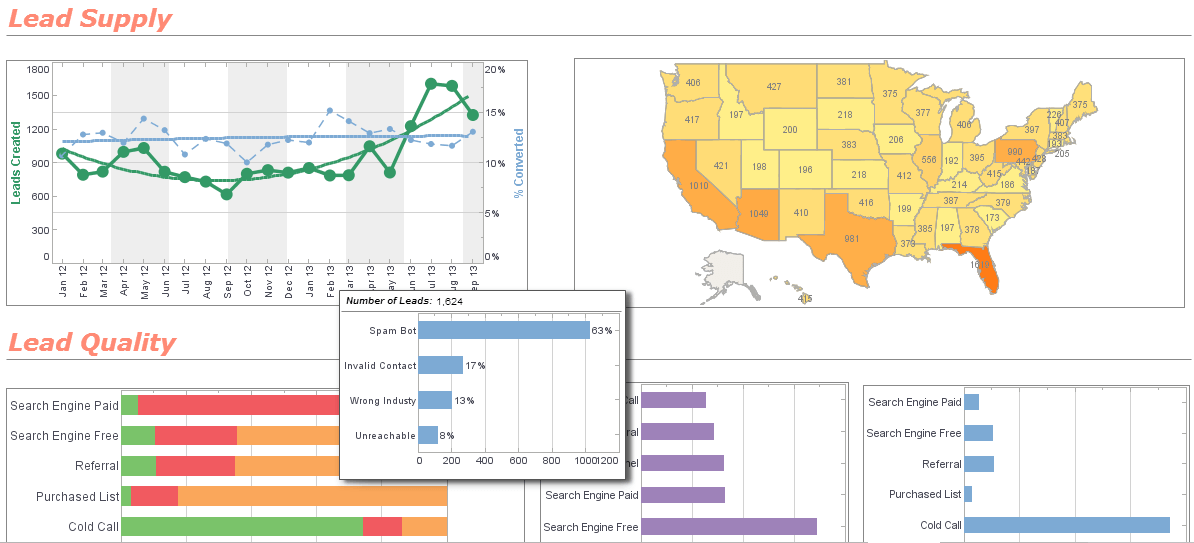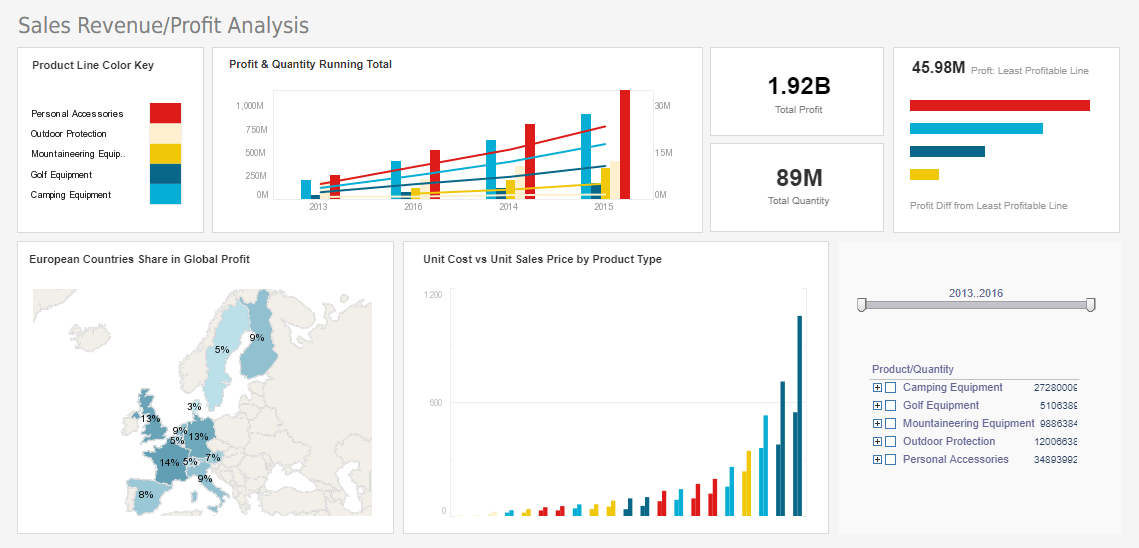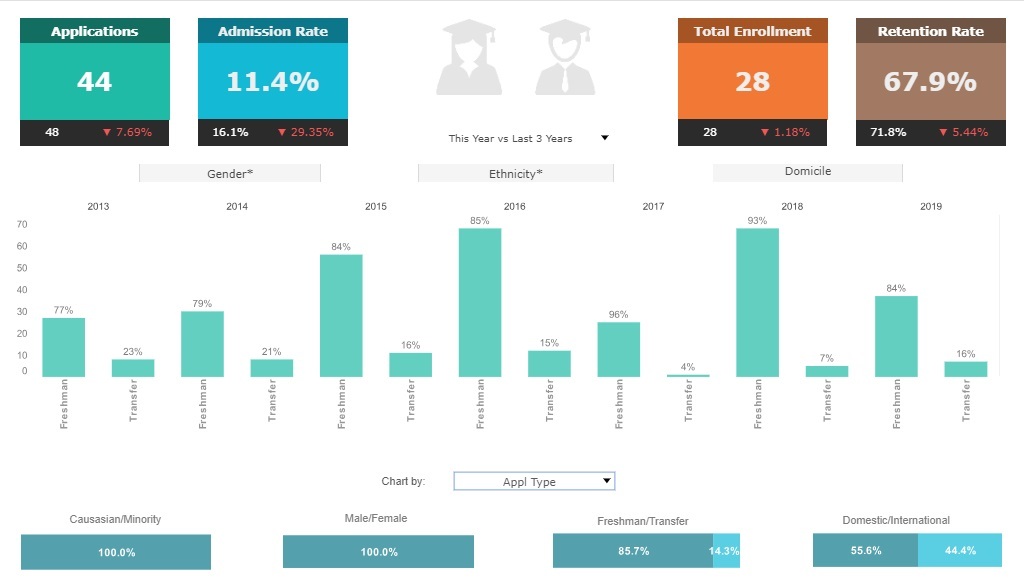InetSoft's Fast BI Solution
Everything about InetSoft's business intelligence solution is quick. StyleBI is a fast BI solution offering easy-to-deploy, easy-to-use monitoring and reporting software.
Implementation
This technology can bring an incredibly rapid solution to a client. InetSoft helps organizations to identify the day-to-day business processes that impact performance, and suggests new means regarding how they can be improved. Those ideas are then turned into running solutions extremely quickly. Basic dashboards can be deployed in just minutes; dashboard solutions in just hours; entire business intelligence solutions, including data preparation, in a matter of weeks.
If you look back to the old times of business intelligence, it took people sometimes years to consolidate and draw relevant data out of systems. Not having a project last for several years is a very important thing.
| #1 Ranking: Read how InetSoft was rated #1 for user adoption in G2's user survey-based index | Read More |
Usage
With the self-service capabilities that StyleBI offers, users can create dashboards and reports on a data warehouse or analytics environment very fast with a new set of users.
InetSoft helps companies manage large volumes of data, but more importantly, strives to deliver better and faster insight into that data which is currently a challenge today.
InetSoft partners with its customers across the full process lifecycle - from their first project, to enterprise deployment, and all the way through business process outsourcing.
Data Management
In many cases, businesses have invested huge amounts of their IT budgets on very fast databases. InetSoft's application is fully capable of leveraging such data warehouse as Teradata, Vertica, and countless others. Users are given the opportunity to connect directly through StyleBI or switch back and forth between their data grid cache and live data source connection.
InetSoft's data grid cache is a feature that enhances the performance of data retrieval and display within their business intelligence solutions. It efficiently stores and manages frequently accessed data, optimizing query response times and overall system responsiveness for a smoother user experience.
InetSoft's agile business intelligence solution addresses the broad need to enable flexibility by accelerating the time it takes to deliver value. A key theme when providing users with BI solutions is to be fast and flexible.
Users will experience high performance scalability for large data sets and large volumes of users via InetSoft's data grid cache technology. This will also minimize a client's cost of ownership by offering IT departments a new means of speeding up queries, rather than the expensive process of creating aggregates, summarizations, and manually figuring out what to index.
 |
Read the top 10 reasons for selecting InetSoft as your BI partner. |
How Do Cannabis Growers Use BI Solutions?
Cannabis growers utilize Business Intelligence (BI) solutions to optimize their cultivation processes and maximize yields. BI tools enable them to analyze data on environmental conditions, plant health, and production metrics, providing insights that help in making informed decisions regarding resource allocation, cultivation techniques, and overall operational efficiency in the highly regulated and competitive cannabis industry.
Cannabis growers leverage Business Intelligence (BI) solutions in several ways to enhance their cultivation practices and business operations:
-
Crop Monitoring and Analysis: BI tools enable growers to monitor plant health, growth patterns, and environmental conditions, allowing for real-time analysis and adjustments to optimize crop quality and yield.
-
Resource Allocation: BI helps in efficient resource management by providing insights into water usage, nutrient levels, and energy consumption. This aids growers in allocating resources more effectively, reducing waste, and improving sustainability.
-
Compliance and Regulation: Given the strict regulations in the cannabis industry, BI solutions assist growers in ensuring compliance with legal requirements. This includes tracking and reporting on cultivation practices, inventory management, and adherence to licensing conditions.
-
Inventory Management: BI tools provide real-time visibility into inventory levels, facilitating better inventory management. This is crucial for tracking product availability, minimizing stockouts, and managing supply chain logistics.
-
Sales and Demand Forecasting: Cannabis growers use BI for analyzing market trends, predicting demand, and optimizing pricing strategies. This helps in managing inventory levels and ensuring that products meet market demand without overproduction.
-
Quality Control: BI solutions assist in monitoring and maintaining product quality by analyzing data related to factors such as THC/CBD content, terpene profiles, and pesticide residues. This ensures that products meet regulatory and consumer standards.
-
Operational Efficiency: By analyzing operational data, BI tools help growers identify bottlenecks and inefficiencies in their processes. This leads to streamlined operations, reduced costs, and improved overall efficiency.
-
Customer Insights: BI helps cannabis businesses understand customer preferences and behaviors by analyzing sales data. This information can be used for targeted marketing, product development, and improving customer satisfaction.
-
Risk Management: Growers utilize BI to assess and mitigate risks associated with factors like weather conditions, pests, and market fluctuations. This proactive approach enhances resilience in the face of unforeseen challenges.
-
Benchmarking and Performance Metrics: BI solutions enable growers to compare their performance against industry benchmarks. This benchmarking helps in identifying areas for improvement and adopting best practices to stay competitive.
-
Financial Analysis: Cannabis growers use BI tools for financial reporting and analysis. This includes tracking expenses, revenue streams, and profitability, providing a comprehensive view of the financial health of the business.
-
Forecasting and Planning: BI supports growers in long-term planning by providing predictive analytics for factors such as future market trends, regulatory changes, and technological advancements.
More Articles About BI Solution Usage
5th Pillar of Data Analytics: Performance - While talking about speed, it was completely about the physical performance of the machine and the model. But the third pillar of performance is about how effectively a model works in analyzing the data. Because not all businesses have structured data. Most of the data acquired comprise unstructured or semi-structured...
Evaluate InetSoft's Predictive Analytics Application - InetSoft offers a powerful BI Solution coupled with predictive analytics enabling organizations harness existing data to the fullest. InetSoft is top-rated by users on G2 Crowd. Interact with examples and register for a personalized demo...
Predictive Analytics at Work - How do we get to this point? What's going on in the background? Essentially it's predictive analytics at work. To simply the situation, there's a scoring mechanism, real time scoring going on in the background as Sarah is talking to Michael. At the outset when Michael makes contact with the insurance company, he tells them he damaged the front bumper of his car when we veered off the...
Resources About Machine Learning Information Systems - InetSoft's machine learning information system is built into its industry pioneering BI platform. Read articles about its capabilities and request a personalized demo. Advanced Machine Learning Algorithms - This post is the eighth in a series discussing a machine learning use case for a mobile app provider. The link to the full case study can be found at the end of the post...





